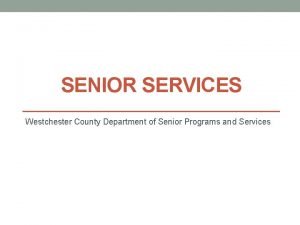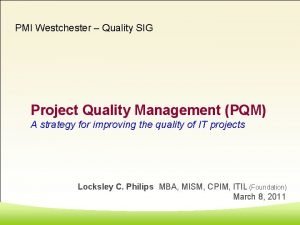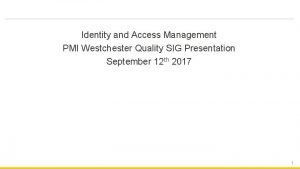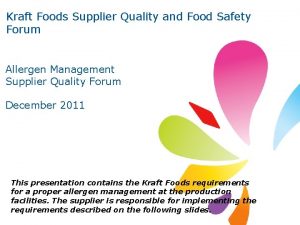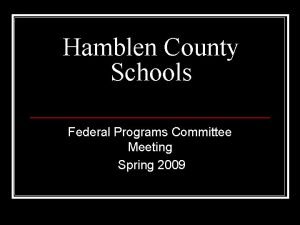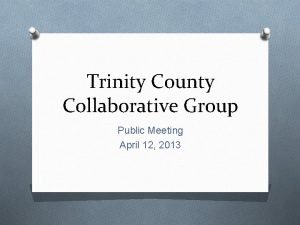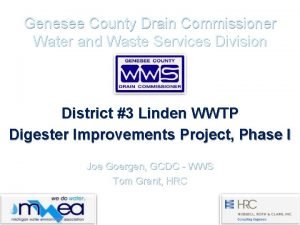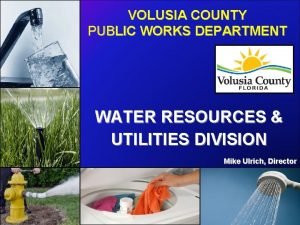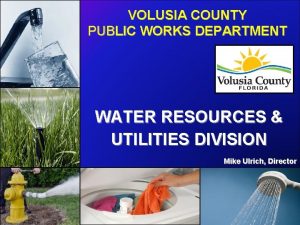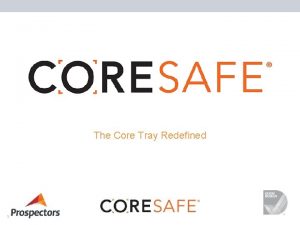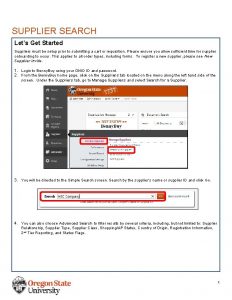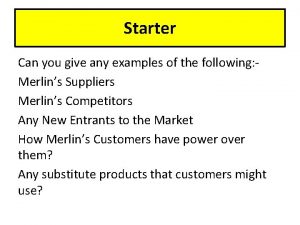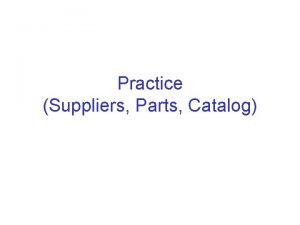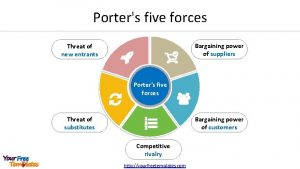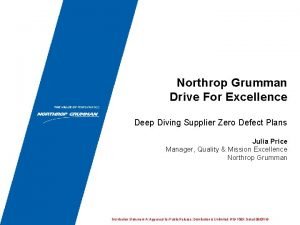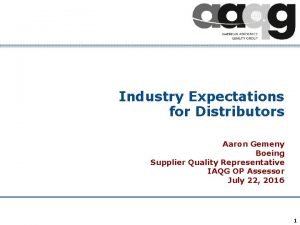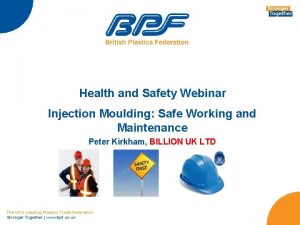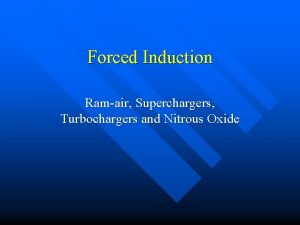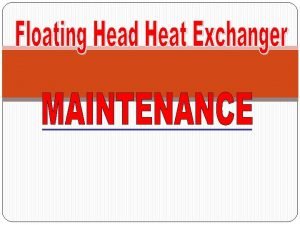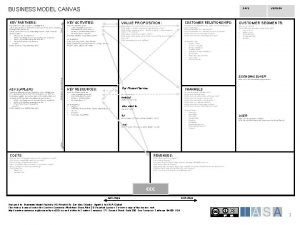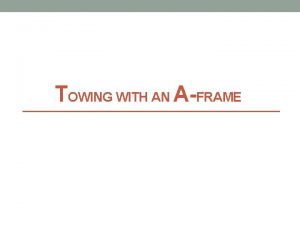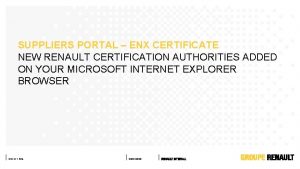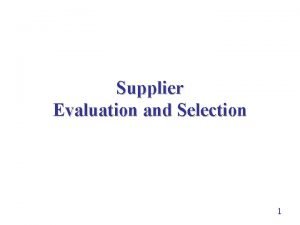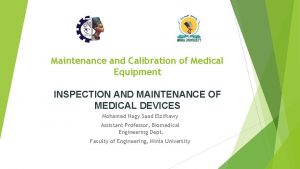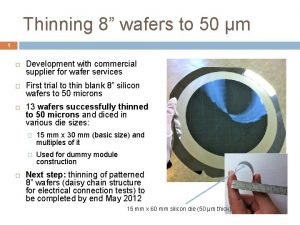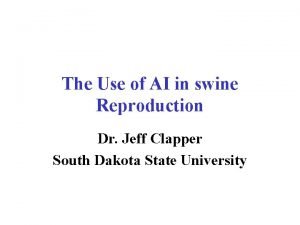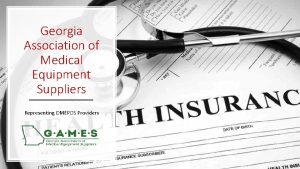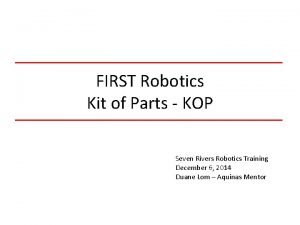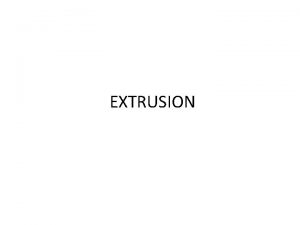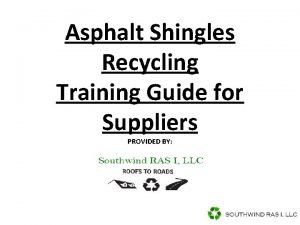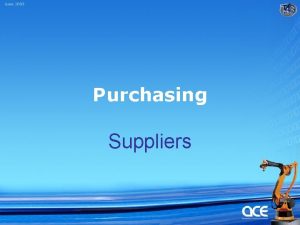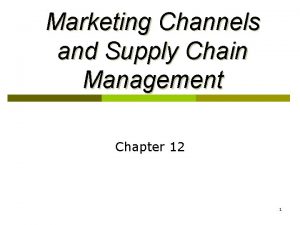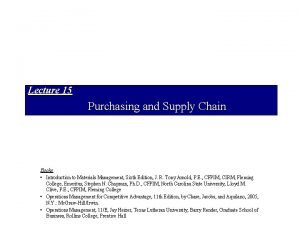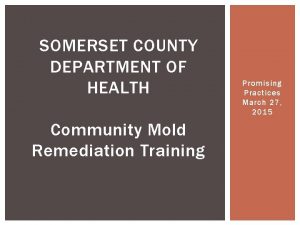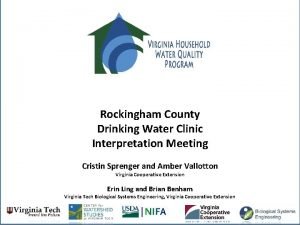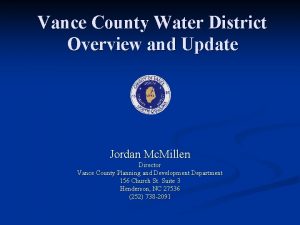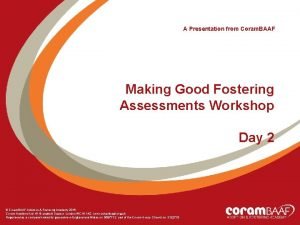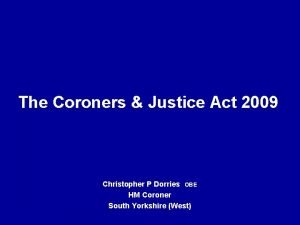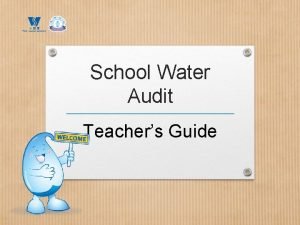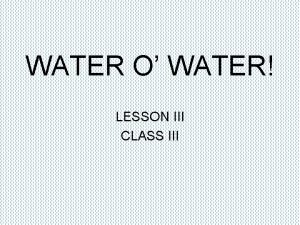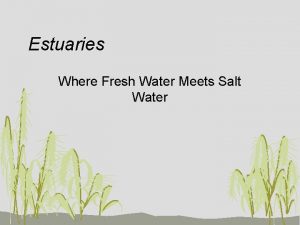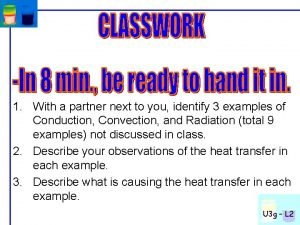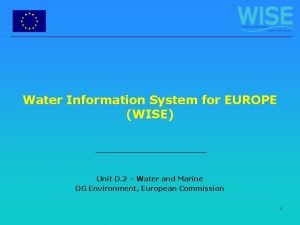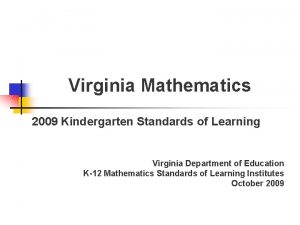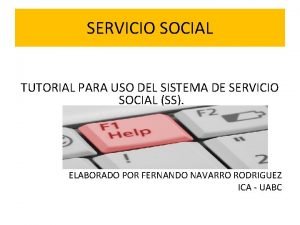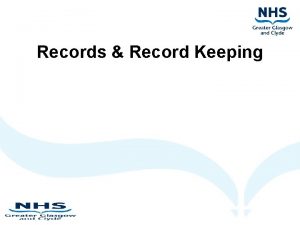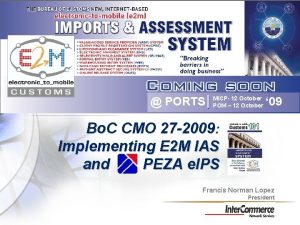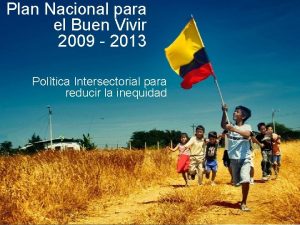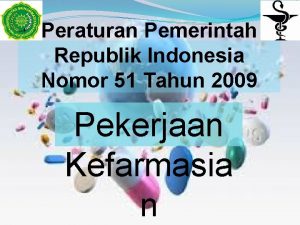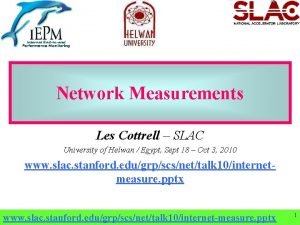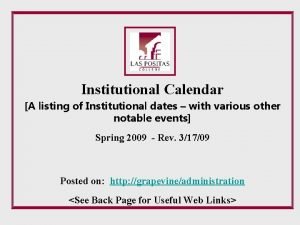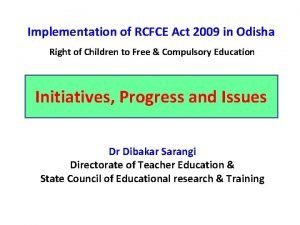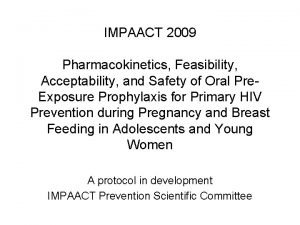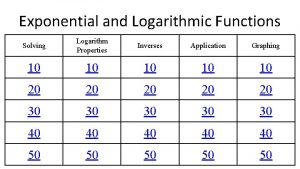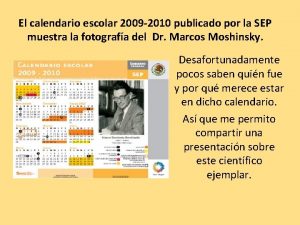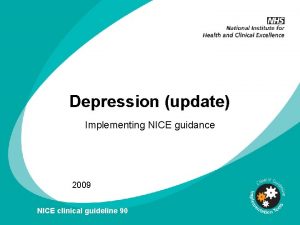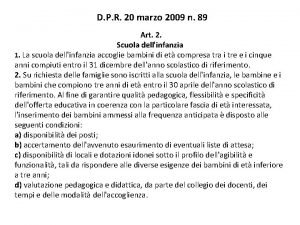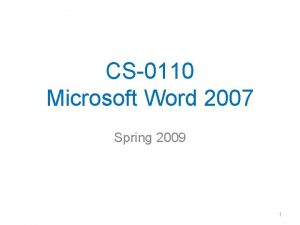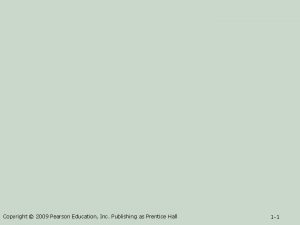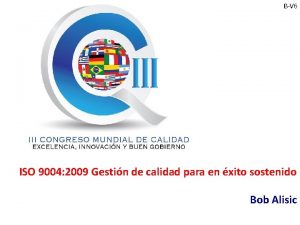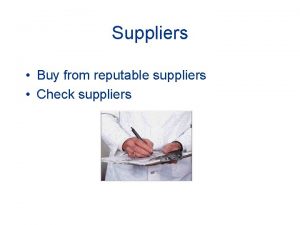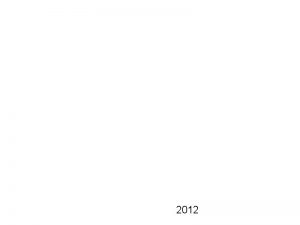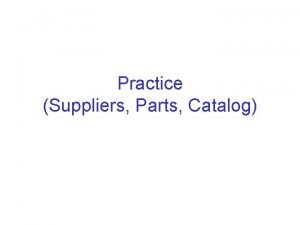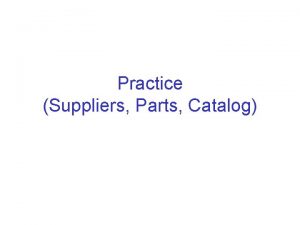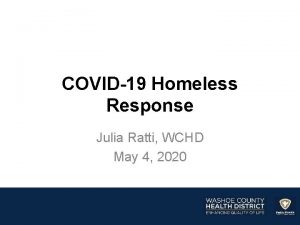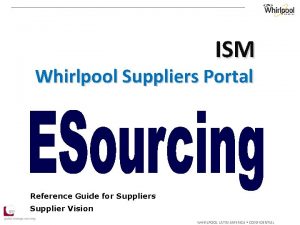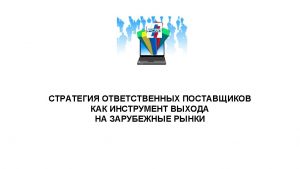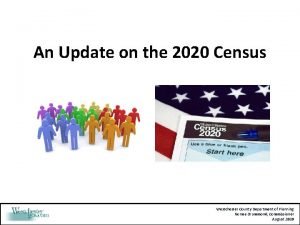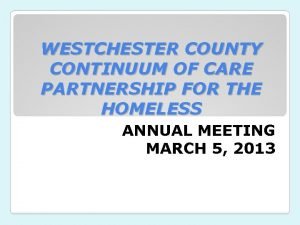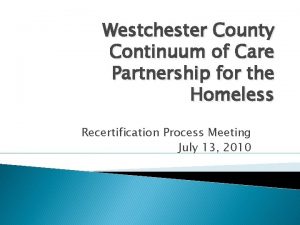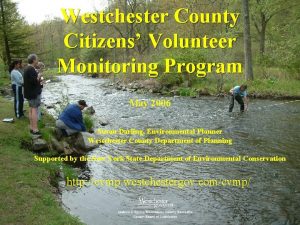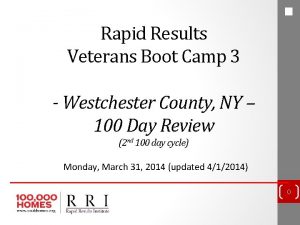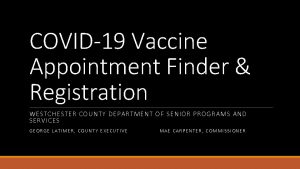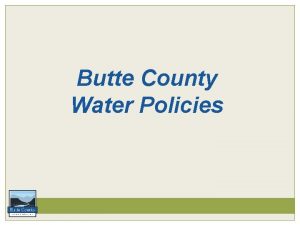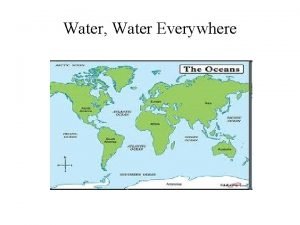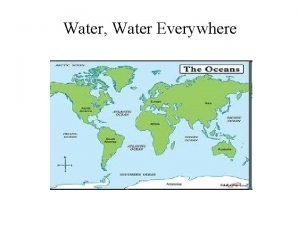2009 WCHD and WESTCHESTER COUNTY WATER SUPPLIERS MEETING






























































































- Slides: 94

2009 WCHD and WESTCHESTER COUNTY WATER SUPPLIERS’ MEETING

STAGE 2 DISINFECTION BYPRODUCTS RULE (DBPR)

OVERVIEW Ø Background Ø Applicability Ø Requirements Ø Schedule

BACKGROUND Ø Finalized by EPA Dec. 2005 Ø Disinfection Byproducts Ø Stage 1 DBPR l l Monitoring: Plant, Source and Population Compliance Calculation: Running Annual Average Ø Stage 2 DBPR l Monitoring: Source and Population

APPLICABILITY Ø Very Small System (VSS) Waivers Ø 40/30 Certification Ø Schedules and CDS

40/30 Certification and VSS Waiver Ø Waiver Effective Immediately Ø Waived from Initial Distribution System Evaluation (IDSE) Ø Must Continue Compliance with Stage 1 DBPR until Stage 2 DBPR Compliance begins

STAGE 2 DBPR Ø Purpose Ø Distribution System Evaluation Ø Monitoring Ø 40/30 Certification and Very Small System Waiver

REQUIREMENTS Ø Population Ø Monitoring Ø IDSE Report Ø Compliance Monitoring Plan Ø Compliance Monitoring

SCHEDULE SCH SYS. Serving 40/30 Cert/Mon. Plan/VSS Waiver Complete SM/SSS IDSE Report 1 ≥ 100, 000 Oct 1, 2006 Sep 30, 2008 2 50, 00099, 999 Apr 1, 2007 Mar 31, 2009 July 1, 2009 3 10, 00049, 999 Oct 1, 2007 Sep 30, 2009 4 <10, 000 Apr 1, 2008 Mar 31, 2010 July 1, 2010 Comp. Monitoring Jan 1, 2009 Apr. 1, 2012 Oct. 1, 2012 Jan 1, 2010 Oct. 1, 2013

Stage 2 Compliance Monitoring Locations Distribution system monitoring location Source water type Subpart H Population size category Monitoring frequency 1 Total per monitoring period 2 Highest TTHM locations Existing subpart L compliance locations Highest HAA 5 locations <500 per year 2 1 1 500– 3, 300 per quarter 2 1 1 3, 301– 9, 999 per quarter 2 1 1 10, 000– 49, 999 per quarter 4 2 1 1 50, 000– 249, 999 per quarter 8 3 3 2 250, 000– 999, 999 per quarter 12 5 4 3 1, 000– 4, 999 per quarter 16 6 6 4 ≥ 5, 000 per quarter 20 8 7 5

Stage 2 Compliance Monitoring Locations Distribution system monitoring location Source water type Ground water Population Monitoring Total per size frequency 1 monitoring category period 2 Highest TTHM locations Existing subpart L compliance locations Highest HAA 5 locations <500 per year 2 1 1 500– 9, 999 per year 2 1 1 10, 000– 99, 999 per quarter 4 2 1 1 100, 000– 499, 999 per quarter 6 3 2 1 ≥ 500, 000 per quarter 8 3 3 2

IDSE Report Contents: Ø Stage 2 Compliance Monitoring Locations 8 -Step Site Selection Protocol 1 Select the location with the highest TTHM LRAA 1 st highest TTHM site 2 Select the location with the highest HAA 5 LRAA 1 st highest HAA 5 site 3 For subpart H systems: Select the existing Stage 1 average residence time compliance monitoring location with the highest HAA 5 LRAA 1 st Stage 1 DBPR site For ground water systems: Select the existing Stage 1 maximum residence time compliance monitoring location with the highest HAA 5 LRAA Skip this step if you have no more Stage 1 sites

IDSE Report Contents: Ø Stage 2 Compliance Monitoring Locations 8 -Step Site Selection Protocol (con’t) 4 Select the location with the next highest TTHM LRAA 2 nd highest TTHM site 5 Select the location with the next highest TTHM LRAA 3 rd highest TTHM site 6 Select the location with the next highest HAA 5 LRAA 2 nd highest HAA 5 site

IDSE Report Contents: Ø Stage 2 Compliance Monitoring Locations 8 -Step Site Selection Protocol (con’t) 7 For subpart H systems: Select the remaining existing Stage 1 average residence time compliance monitoring location with the highest TTHM LRAA For ground water systems: Select the remaining existing Stage 1 maximum residence time compliance monitoring location with the highest TTHM LRAA Skip this step if you have no more Stage 1 2 nd Stage 1 DBPR site 8 Select the remaining location with the next highest HAA 5 LRAA 3 rd highest HAA 5 site Go back to Step 1 of this protocol and repeat the steps until you have selected the required number of total sites.

SUMMARY Ø DBPR Requirements Ø Schedule/Time Line Ø Monitoring Plan Ø Monitoring

Long Term 2 Enhanced Surface Water Treatment Rule LT 2

Overview Ø Purpose & Background Ø LT 2 Overview Ø Schedules & Timeline Ø Process Ø Bin Classification Ø Implementation Ø Summary

Purpose & Background Ø Finalized by EPA Dec. 2005 Ø Improve Public Health Protection Ø Cryptosporidium Ø Current Surface Water Treatment Rule Ø Who Does It Apply To?

LT 2 Overview Ø What is LT 2? Ø Source Water Monitoring Ø Screening Procedure for Small Systems Ø Treatment for Higher Risk Systems Ø Crypto Inactivation Ø Uncovered Storage Facilities

Schedules & Timeline Schedule Criteria Schedule 1 System or CDS serving ≥ 100, 000 people 1 Apr 1, 2012 2 System or CDS serving 50, 000 -99, 999 people 2 Oct 1, 2012 3 System or CDS serving 10, 000 -49, 999 people 3 Oct 1, 2013 4 System or CDS serving ≤ 10, 000 4 Oct 1, 2014 Treatment Installation

Process Implementation Ø Source Water Monitoring Ø Bin Classification Ø Treatment Ø Implementation Ø Second Round of Source Water Monitoring

Bin Classification Based on Source Water Monitoring ØBin. Treatment Requirements Conventional Direct filtration Slow sand or Ø filtration treatment (including softening) diatomaceous earth filtration Alternative filtration technologies 1 No additional treatment 2 1 -log treatment 1. 5 -log treatment 1 -log treatment (1) 3 2 -log treatment 2. 5 -log treatment 2 -log treatment (2) 4 2. 5 -log treatment 3 -log treatment 2. 5 -log treatment (3)

SCHEDULE 4 Ø < 10, 000 Ø Letter of intent Ø Treatment Installation by October 1, 2014

Summary Ø Source Water Monitoring Ø Bin Classification Ø Treatment

Ground Water Rule (GWR)

Ground Water Rule Finalized by EPA Oct. 2006 • Rule Implementation: December 1, 2009 • Purpose: • - Identify PWS with poor source water quality Identify significant deficiencies during sanitary surveys Systems that are identified may be required to: • • Correct all significant deficiencies Replace source Remove contaminant sources Install treatment to fully protect customers

GWR Applicability Applies to PWS with: • Ground water sources • Consecutive systems receiving ground water • Mixed SW & GW systems – if any GW source doesn’t not mix with SW prior to treatment Does not Apply to PWS with: • GWUDI • Mixed SW & GW systems – if all GW source is mixed with SW prior to treatment

Key Provisions of the GWR • • Source Water Monitoring Sanitary Surveys of all GWS Corrective Actions for Significant Deficiencies and Fecal Contamination Compliance Monitoring

Source Water Monitoring Provisions New Sources: • Assessment Monitoring Required – source water assessment monitoring to identify high risk systems Existing Sources: • Triggered Monitoring – systems that do not provide 99. 99% (4 -log) treatment and have a positive total coliform sample under the Total Coliform Rule

Assessment Monitoring • Evaluation of source water over time to see whether fecal contamination is present - - Frequency and length of study to be determined by State Fecal Indicator to be determined by State

What Triggers the GWR? • • • Significant deficiencies observed during sanitary survey Total Coliform positive sample in distribution New systems

GWR Triggered Monitoring Due to Total Coliform in Distribution Repeat sample location within 24 hours • Sample all raw water at source • - If fecal contamination is confirmed • 5 additional samples from same source within 24 hours • Any of the 5 samples are positive – must comply with Treatment Technique Requirements and Compliance Monitoring

Public Notification for Fecal Indicator at Source Must provide Tier 1 Public Notification • All Consecutive Systems must issue Tier 1 Public Notification •

GWR Trigger – Significant Sanitary Survey Deficiencies 8 Critical Elements of a Sanitary Survey 1. 2. 3. 4. 5. 6. 7. 8. Source Treatment Distribution System Finished Water Storage Pumps, Pump Facilities, and Controls Monitoring, Reporting, and Data Verification System Management and Operation Operator Compliance with State Requirements

Sanitary Survey Follow-Up LHD sends notice to system of need for corrective action • Issue Enforcement Action • Administrative Hearing • Setup milestones for compliance •

New Systems Coming Online After November 30, 2009 • Must be designed to achieve 4 -log virus inactivation and begin compliance monitoring within 30 days of activation - • Will be capable of meeting GWR requirements if they are triggered into it Includes existing systems that make significant modifications to treatment process or expansion to system

Compliance Monitoring • Applies only to Systems that provide 4 log virus removal - Inactivation Removal State-approved combination of 4 -log inactivation and removal State must be notified in writing of intention to begin compliance monitoring • Compliance monitoring avoids triggered source water monitoring •

Compliance Monitoring (Cont’d) Chemical Disinfectant • Systems serving >3300 people - • Continuous monitoring of disinfectant residual Maintain a State determined minimum residual Record lowest daily residual value Continuous monitoring equipment failure - Grab sample every 4 hours Repair equipment within 14 days

Compliance Monitoring (Cont’d) Chemical Disinfectant • System serving ≤ 3300 people Take daily grab samples during peak hourly flow OR - Meet all requirements for systems serving >3300 people - • If disinfectant residual falls below State minimum - Take sample every 4 hours until residual meets required level

Early Implementation Requirements All PWS must comply prior to Dec 1, 2009 • Install raw water taps at all individual GW sources • Evaluate system zones • Install water meter on system • Notification Protocol for Consecutive Systems - - Be able to notify supplier to sample sources within 24 hours Be able to notify other consecutive supplies of Tier 1 Public Notification

CROSS CONNECTION CONTROL AND BACKFLOW PREVENTION PROTECTING YOUR WATER

TOPICS Ø OVERVIEW Ø DESIGN , APPROVAL OF PLANS & INSTALLATION Ø TESTING & MAINTENANCE Ø RECORD KEEPING Ø RECOMMENDATIONS

LEGAL AUTHORITY Ø STATE LAW/REGULATION-NYSDOH -LAW: Public Health Law Sec. 225(10) -REGULATION: Subpart 5 -1. 31 of the State Sanitary Code “all public water systems are Required to have a Cross-Connection Program” -REGULATION: NYS Department of State Plumbing code of NYS

PUBLIC WATER SYSTEM Ø COMMUNITY WATER SYSTEMS Ø NON-COMMUNITY Ø NON-TRANSIENT Ø TRANSIENT

BACKFLOW PREVENTION DEVICES DESIGN AND INSTALLATION Ø TYPES OF DEVICES Ø PREPARING PLANS FOR APPROVAL OF INSTALLATION AND SUBMITTING TO WCDH FOR REVIEW & APPROVAL Ø ENGINEER’S REVIEW COMMENTS Ø WATER PURVEYOR ROLE WHEN PLANS ARE SUBMITTED AND AFTER APPROVAL Ø WCDH CERTIFICATE OF APPROVAL & CONDITIONS OF APPROVAL

FORM DOH-1013 Ø BACKFLOW PREVENTION DEVICE TESTING Ø COMPLETION OF Part A & Part B Ø SUBMISSION OF FORM TO WCDH Ø MAINTENANCE

WCDH RESPONSIBILITY Ø PROVIDE GUIDANCE TO WATER PURVEYORS Ø TO ENSURE COMPLIANCE WITH NYSDOH AND WCDH SANITARY CODES Ø ISSUE VIOLATIONS Ø SANITARY SURVEYS (checking for cross connections)

WATER SUPPLIER RESPONSIBILITY Ø TO ASSURE THAT ALL CROSS CONNECTIONS ARE PROTECTED Ø TO DETERMINE THE DEGREE OF HAZARD FROM A FACILITY TO THE WATER SYSTEM AND TO REQUIRE THAT A BACKFLOW PREVENTER DEVICE BE INSTALLED, TESTED, OPERATED AND MAINTAINED AND THAT ADEQUATE RECORDS OF MAINTENANCE AND REPAIRS ARE KEPT

RECOMMENDATIONS Ø EFFECTIVE RECORD KEEPING TO DEMONSTRATE COMPLIANCE Ø ASSIGN CROSS-CONNECTION RESPONSIBILITY TO KEY PERSONNEL Ø NOTIFY AND EDUCATE CUSTOMERS ON THE NEED FOR SYSTEM PROTECTION WHEN BACKFLOW DEVICES ARE REQUIRED Ø DEVELOP A EFFECIVE BF PROGRAM FOR THE ELIMINATION OR PROTECTION OF ALL CROSS CONNECTIONS

Changes to Lead and Copper Rule (LCR) (Effective 2010? )

Applicability l l Applies to Community and Non Community Non Transient PWS Not applicable to Transient Non Community PWS

GENERAL CHANGES Ø Ø Applicable to all Community and Non Transient Non Community Systems Monitoring Requirements l Allow Systems with low lead and copper tap levels to immediately reduce lead and copper tap monitoring and Water Quality Parameter (WQP) monitoring to once every 3 years

l l l Allow NTNCWS and certain CWS not having enough taps where water has stood motionless for at least 6 hours, to collect a sample from the tap with the longest standing time. Flexibility in time of year when systems can conduct reduced monitoring Permit some ground water systems to limit Biweekly entry point monitoring to representative locations

l l l Grant monitoring waivers to small systems with plumbing free of lead and copper containing material Clarify and provide flexibility in sampling site requirements Permits Health Department to invalidate tap samples (conditions apply)

l l l Clarify number of samples required Clarify number of sites from which samples should be collected Clarifies need for a 9 year monitoring waiver for “Lead-Free” systems Modifies definitions for monitoring and compliance periods “All samples must be taken within the same calendar year” New Reduced monitoring requirements – prevents water systems to remain on reduced monitoring when in non-compliance with WQP levels

Public Education Ø l l l Lead or Copper exceedance Allow NTNCWS and special case CWS to use alternative language Flexibility in mode of delivery (especially those supplies serving 3, 300 or fewer people) l Message content l How materials are delivered l Timeframe of delivery l Delivery requirements which include additional organizations l PWS to provide results to customers whose tap water was sampled, along with public awareness information

Ø Analytical Methods Ø Reporting and Record Keeping Requirements l l Remove redundant reporting requirements Revise record keeping Customer Awareness Ø l l Notification of sampling results Public Education Requirements

CHANGES TO SYSTEMS WITH TREATMENT Ø Demonstration of Optimal Corrosion Control l Community and Non community Non Transient PWS with Treatment l l Continue to maintain and operate existing corrosion control Systems deemed optimized l l Monitor for lead and copper tap samples once every 3 years Meet the copper action level

l State designated Water Quality Parameters l Ø Way in which compliance is determined Lead Service Line Replacement Requirement l Applicability - Systems subject to lead service line replacement l l l Requires replacement of the portion of lead service line that is owned by PWS Notify residents of the potential for temporary increases in lead levels and measure they can take to reduce lead levels Reconsideration of lead service lines deemed replaced through testing

Ø Water Treatment Requirements l Advanced notification and approval requirement for water systems that intend to make any change in water treatment or add a new source of water that could affect the system’s optimal corrosion control

Annual Water Quality Report (AWQR) Ø Applicable to Community PWS l l l Requires lead in drinking water educational statement in all AWQRs PWS written education statement (alternate) Requires specific public ed language to be included in AWQR

Additional Information l l EPA’s “Minor Revisions” (Jan. 12, 2000) • www. epa. gov/EPA-WATER/2000/January/Day 12/w 3. pdf “Short Term Revisions” (October 10, 2007) • www. epa. gov/fedrgstr/EPAWATER/2007/October/Day-10/w 19432. pdf

RADIONUCLIDES MONITORING (Refresher)

Radionuclides Monitoring Ø Applicable Regulations l l Ø New York State Sanitary Code Part 5, Subpart 5 -1, Section 5 -1, Table 7 Who is required to do the monitoring? l Ø US-EPA 40 CFR Part 9, 141, 142 All Community Public Water Supplies (CPWS) Who is not required to the monitoring? l l Non Community Public Water Supplies Consecutive Community Public Water Supplies

RADIONUCLIDES MONITORING (cont’d) Initial Monitoring Requirement Ø Four Consecutive Quarter Monitoring l Gross Alpha (Gα) l Radium 226 (Ra-226) l Radium 228 (Ra-228) l Uranium (U)

Radionuclides Monitoring (cont’d) Ø Maximum Contaminant Level (MCL) l Gα including Ra-226 15 p. Ci/L l Ra-226 & Ra-228 5 p. Ci/L l Uranium 30 ug/L (20 p. Ci/L)

Radionuclides Monitoring (cont’d) Result Analysis and Schedule Determination Ø Monitoring Results of Radionuclides (Gross α, Rad-226, Rad-228, U) l Below detection limit → 9 year l Detection Limit ≤ Results ≤ ½ MCL → 6 year l ½ MCL value < Results ≤ MCL → 3 year l Results > MCL → Quarterly

Radionuclides Monitoring (cont’d) Compliance Schedule Determination Ø Compliance based on Source Monitoring Ø If there are multiple sources; compliance schedule will be determined by the value of the contaminant which project the shortest monitoring schedule Ø If one or more of the multiple sources exceed MCL; entry point sampling will be required and compliance schedule will be determined by the entry point result

Radionuclides Monitoring (cont’d) Ø Statistics l Total 100 CPWS • 77 CPWS required to conduct Radiological monitoring l 18 systems on 9 year schedule l 46 systems on 6 year schedule l 9 systems on 3 year schedule l 4 systems on quarterly schedule • Based on the review of 3 yearly sample results submissions, 1 system required increase monitoring to quarterly schedule

Drinking Water State Revolving Fund

DRINKING WATER STATE REVOLVNG FUND (DWSRF) Ø Result of 1998 Safe Drinking Water Act (SWDA) EPA allotted grant funding to each State based on each state proportional share based on infrastructure needs survey & assessment Ø NYS – 2009 Allotment $86, 811, 000. 00 Allotment $96, 724, 000. 00 2010 Tentative Ø Program Administered by the NYS Environmental Facilities Corporation (NYSEFC) & NYS Department of Health (NYSDOH) Ø Provides subsidized low interest rate financing and limited grants for construction of eligible water system projects.

Ø For communities with demonstrated financial interest rates can be reduced to as low as 0% Ø Severe financial hardship – Financial hardship grants may be available thru SWDA Ø Eligible Drinking Water Systems: l Community Water Systems: Municipal and Privately Owned l Non-Profit, Non Community Water Systems Ø More information available at: l www. NYSEFC. Org/Home/Index. ASP? page=15

Additional Funding Ø Appropriation under the American Recovery and Reinvestment Act (ARRA) of 2009 Ø Short term goal to identify projects that can achieve ARRA goal to commence construction activity within 120 days of enactment. Ø Long term goal to commit all funds of ARRA to projects to be under contract for construction by February 17, 2010. Ø ARRA requires 20% of funds to be utilized for projects that incorporate green infrastructures, energy efficiency, water efficiency, and/or environmentally innovative activity.

TYPES OF ELIBGIBLE PROJECTS: Ø Rehabilitation or development of new drinking water sources to replace contaminated supplies Ø Installation or upgrade of treatment facilities to ensure compliance with State and Federal Drinking Water Standards or Treatment/Performance Criteria Ø Installation or upgrade of storage facilities, including finished water reservoirs to prevent microbiological contamination or to provide adequate delivery pressures Ø Installation or replacement of transmission and distribution mains to prevent contamination caused by leaks or breaks. Ø Purchase of a portion of another system if the purchase is part of a consolidation plan to bring the system(s) into compliance. Ø Capital investments to improve the security of Drinking Water Systems

APPLICATION PROCESS Two Step Process: 1. Pre-application form to NYSDOH Ø Ø Project Information Contact Information Project Schedule Project Cost Estimate Above is used to list and rank projects in the Intended Use Plan (IUP)

2. A complete DWSRF Financial Application to NYSEFC publicly or privately owned facilities Ø Ø Complete series of forms/application/information Financial Information – long term Construction Costs Economic & Financial Data Application forms and more information available at: www. NYSEFC. Org/Home/Index. ASP? page=15

ONGOING ISSUES

ONGOING ISSUES ØSanitary Surveys ØMicrobiological Monitoring and Operations Reports ØMonitoring of GWUDI Supplies ØVulnerability Assessment

SANITARY SURVEYS Ø Sample Schedules Ø Security Checklist Ø PWS Representatives l l l DO Treatment DO Distribution Cross Connection Control Program Designated Representative

MICROBIOLOGICAL MONITORING AND OPERATIONS REPORTS

MICROBIOLOGICAL MONITORING AND OPERATIONS REPORTS Ø Sampling Plans l l Site Selection Criteria Approved Plans Ø Monitoring Requirements l l Number of Samples Time of Sampling

MICROBIOLOGICAL MONITORING AND OPERATIONS REPORTS Ø Operations Reports l l Minimum Requirements Submission Deadline

MONITORING OF GWUDI SUPPLIES

MONITORING OF GWUDI SUPPLIES Ø Microbiological Monitoring l l Sampling Frequency Number of Samples

MONITORING OF GWUDI SUPPLIES Ø Disinfection/Disinfectants Byproducts Monitoring Requirements Population Routine Reduced >10, 000 4/Qtr/TP 1/Qtr/TP 500 -9, 999 1/Qtr/TP 1/Yr/TP <500 1/Yr/TP

MONITORING OF GWUDI SUPPLIES Ø Turbidity Monitoring l Unfiltered Systems v v v l Continuous/Every 4 hours at source 1 sample/day at entry point (C) 1 sample/year at entry point (NC) Filtered Systems v v Continuous monitoring of effluent 5 samples/week in distribution

VULNERABILITY ASSESSMENTS Required VA and ERP Ø VA Certifications Ø Security Checklist Ø Updated VA Review Ø Additional Information EPA-Water Security-Vulnerability Assessment Ø http: /cfpub. epa. gov/safewater/watersecurity/home. cfm? program

SDWIS-Web AND DRINKING WATER WATCH

SDWIS-Web AND DRINKING WATER WATCH Ø SDWIS l Safe Drinking Water Information System Ø Previous Versions Ø SDWIS-Web l l Availability Impact

SDWIS-Web AND DRINKING WATER WATCH Ø Drinking Water Watch l l l Availability Types of Information Access Ø Laboratory Data Input l l Sampling Sites Impact

DESIGNATED OPERATOR IN RESPOSIBLE CHARGE

DESIGNATED OPERATOR IN RESPONSIBLE CHARGE Ø Current situation l l PWS requiring Designated Operators Systems Classifications ~ IA, IB, IIB, C, D Operator Grades Levels ~ IA, IB, IIB, C, D Enforcement

DESIGNATED OPERATOR IN RESPONSIBLE CHARGE Ø Enforcement changes l l l Operator Grades Operator Grade Hierarchy Effective Date

2009 WCHD and WESTCHESTER COUNTY WATER SUPPLIERS’ MEETING
 Water and water and water water
Water and water and water water Heap westchester county
Heap westchester county What is meeting and types of meeting
What is meeting and types of meeting What is meeting and types of meeting
What is meeting and types of meeting John lettera
John lettera Pqm quality management
Pqm quality management Pmi westchester
Pmi westchester Joint meeting of essex and union counties
Joint meeting of essex and union counties Today meeting or today's meeting
Today meeting or today's meeting Meeting objective
Meeting objective Internal supplier
Internal supplier Raw template
Raw template Vddf
Vddf Hamblen county school board meeting
Hamblen county school board meeting Trinity county board of supervisors meeting
Trinity county board of supervisors meeting Genesee waste
Genesee waste Volusia county water and sewer
Volusia county water and sewer Volusia county water
Volusia county water Core tray suppliers
Core tray suppliers Key patners
Key patners 5 suppliers criteria
5 suppliers criteria Merlin entertainment competitors
Merlin entertainment competitors Suppliers parts catalog database
Suppliers parts catalog database Bargaining power of buyers
Bargaining power of buyers Northrop grumman suppliers
Northrop grumman suppliers Boeing supplier portal
Boeing supplier portal Health and safety for injection moulding
Health and safety for injection moulding Screw type oil -free nitrogen supercharger suppliers
Screw type oil -free nitrogen supercharger suppliers Floating head heat exchanger for house
Floating head heat exchanger for house Key club logo
Key club logo What must be done after receiving a key drop delivery?
What must be done after receiving a key drop delivery? Key suppliers business model canvas
Key suppliers business model canvas Towing a frame suppliers
Towing a frame suppliers Renault suppliers portal
Renault suppliers portal Key supplier evaluation criteria
Key supplier evaluation criteria General purchasing and receiving principles
General purchasing and receiving principles Biomedical equipment maintenance checklist
Biomedical equipment maintenance checklist Tourism service providers
Tourism service providers Wafer back thinning suppliers
Wafer back thinning suppliers Golden pig catheter
Golden pig catheter Seismic cables manufacturers
Seismic cables manufacturers Lost wax process suppliers
Lost wax process suppliers Medical equipment suppliers association
Medical equipment suppliers association First robotics suppliers
First robotics suppliers Freelife kendo white
Freelife kendo white Multi-layers co-extrusion cast film die head
Multi-layers co-extrusion cast film die head Shingle recycling near me
Shingle recycling near me Suppliers objectives
Suppliers objectives Conventional marketing channel
Conventional marketing channel Who are the demanders of loanable funds
Who are the demanders of loanable funds Invoiceless purchasing
Invoiceless purchasing Fwa kapal adalah
Fwa kapal adalah Mold remediation somerset county
Mold remediation somerset county Water treatment rockingham county
Water treatment rockingham county Vance county water district
Vance county water district Water mitigation pike county
Water mitigation pike county Discrepancy matrix
Discrepancy matrix Coroners and justice act 2009
Coroners and justice act 2009 Saunders lewis and thornhill 2009
Saunders lewis and thornhill 2009 How to draw 1/5
How to draw 1/5 School water audit
School water audit How can we reuse water for class 3
How can we reuse water for class 3 Alberto rode 5/8 of the water rides at a water park
Alberto rode 5/8 of the water rides at a water park A paved blacktop parking lot was built
A paved blacktop parking lot was built Water heat exchanger
Water heat exchanger Fresh water meets salt water
Fresh water meets salt water Warm water rises in a lake. cold water descends.
Warm water rises in a lake. cold water descends. Clil water
Clil water Important of water resources
Important of water resources Unit 11 water water everywhere
Unit 11 water water everywhere 2008-2009 school year
2008-2009 school year 2009 mathematics standards of learning answers
2009 mathematics standards of learning answers Sistema de servicio social uabc
Sistema de servicio social uabc Uma máquina fotográfica custava r$ 400
Uma máquina fotográfica custava r$ 400 Record keeping nmc
Record keeping nmc Vasp customs
Vasp customs Plan nacional del buen vivir 2009 al 2013
Plan nacional del buen vivir 2009 al 2013 Permenkes no 51 tahun 2009
Permenkes no 51 tahun 2009 R.t.t. 2009
R.t.t. 2009 January 2018 chemistry regents
January 2018 chemistry regents Institutional calendar
Institutional calendar Rcfce
Rcfce Impaact 2009
Impaact 2009 In 2009 there were 1570 bears
In 2009 there were 1570 bears Rosa catania 2009
Rosa catania 2009 Calendario escolar 2009 a 2010 sep
Calendario escolar 2009 a 2010 sep Nice 2009
Nice 2009 Decreto 1290 de 2009
Decreto 1290 de 2009 Dpr 89/2009
Dpr 89/2009 Microsoft word 2009
Microsoft word 2009 2009 pearson education inc
2009 pearson education inc Chapter 6:2 interpreting word parts
Chapter 6:2 interpreting word parts 2009 delmar cengage learning
2009 delmar cengage learning 2009 delmar cengage learning
2009 delmar cengage learning Iso 9004 2009
Iso 9004 2009

